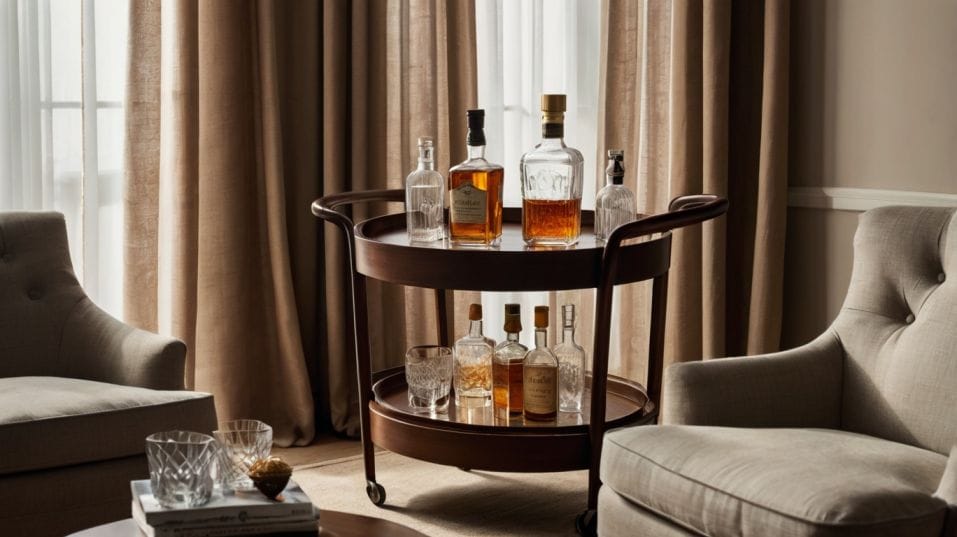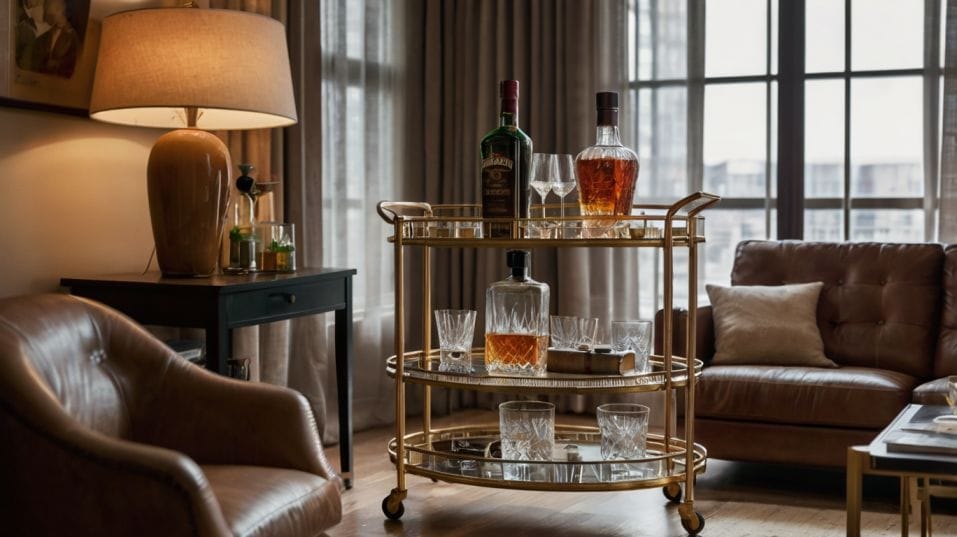Where to Place Your Bar Cart for Maximum Vibes
Set your bar cart for more than looks. Learn where to place it to build better habits, taste with clarity, and grow your whiskey confidence.

Where should your bar cart go if you want every pour to mean something? Not just to impress guests—but to shape how you taste, think, and come back for more.
If you’re starting to care about what’s in the glass, placement isn’t just design—it’s strategy. The right spot makes whiskey part of your rhythm, not just your décor. Here’s how to place your bar cart so it actually elevates your experience.
Make It Part of the Room, Not an Afterthought
The biggest mistake? Treating your bar cart like a mini-fridge or a side table—functional, but invisible. A good cart doesn’t sit in the wings.
It belongs in the action. But it doesn’t scream either. It should feel deliberate, like a well-placed accent in music.
If you tuck it behind a door or cram it between the couch and a wall, you’re turning it into dead space. That signals—subtly—that your whiskey is optional, secondary. Not something worth paying attention to.
Instead, anchor it somewhere with flow:
- Against a clean wall near where you actually sit and think.
- Across from a turntable or bookshelf.
- Just outside your kitchen zone—close enough to draw you in when the knives are down and dinner's resting.
When you see your bar cart without needing to “go find it,” it becomes part of your rhythm. A natural extension of your night.

Design a Pour Zone That Supports Movement
Whiskey isn’t just consumed—it’s handled. Observed. Measured. Opened. Oxidized. Every pour is a tiny ritual, and your body remembers friction. A clunky setup? You’ll skip steps. Pour fast. Miss nuance.
Make It Ergonomic
Think ergonomically. You want:
- Clear reach zones: no weird bends or stretches.
- Nothing obstructing arm movement: not a lamp, not a plant, not the edge of a couch.
- Flat, stable surfaces: even slight wobble messes with your confidence.
Top-tier is for glasses and accessories you reach for often. Mid-tier holds open bottles in active rotation.
Lower shelves are for your quiet stock—things you’re saving, or tasting slowly over time. And don't sleep on airflow. Good whiskey deserves a bit of breathing space.
If your cart is a tight mess or shoved into a dead-end nook, you’re more likely to treat whiskey like an occasional indulgence.
But if it’s well-placed, with enough physical and mental room to move? You’ll approach every pour with a little more presence.
Use Light to Your Advantage
The best whiskey experiences start before the first sip. You look at the glass. You notice the color. Maybe even the viscosity. That golden-red hue tells you about age, barrel, mash, and strength—if the light lets it.
This is why bar carts shouldn’t live in the dark. But don’t fall into the “spotlight” trap, either. Harsh downlighting turns every bottle into glare. Makes it harder to distinguish between an 8-year wheated bourbon and a sherried single malt.
Set the Right Lighting Conditions
Go for ambient, indirect light:
- Near a warm table lamp (not overhead fluorescents).
- By a window with gauzy curtains, softening the daylight.
- Even under a dim track light aimed just beside—not on—the cart.
The point isn’t to dazzle. It’s to let the bottles glow gently. To make it easier to read a label, see the color in your glass, and let the environment reflect the stillness you’re trying to cultivate.
Curate for Movement, Not Display
This one’s easy to miss—especially early on, when it’s tempting to collect more than you taste. But remember this: a bar cart is a reflection of your current taste journey, not your trophy shelf.
If bottles are just sitting there for show, you’ll hesitate to open them. You’ll start collecting like a hoarder instead of drinking like a student. Don’t go there.
Keep It Active, Not Static
Instead:
- Keep open bottles in rotation—if something’s been sealed for six months, ask why.
- Highlight what you’re currently learning from—peated scotches, bonded bourbons, low-rye mash bills.
- Let your tools show. The pipette, the jigger, the tasting notebook—they all signal movement.
This isn’t about clutter. It’s about creating an active zone. A working bench for your evolving palate.
Even glassware says something. If your cart has one good Glencairn and three novelty tumblers from some gimmicky club, you’re sending yourself mixed messages. Clean it up. Use what sharpens your senses.
Connect It to Your Ritual, Not Just Your Furniture
The strongest placements aren’t just practical—they’re personal. A good bar cart becomes part of a wider ritual. It doesn’t just hold your bottles. It cues a mindset shift.
Make the Cart Part of a Broader Habit
- Next to your vinyl? Now you’re tasting while listening. You’ll notice tempo in the dram—how a rye buzzes against jazz or how a Speyside blooms under slow soul.
- Near your reading chair? The whiskey becomes part of the narrative. Sipped slowly between pages. Layered like prose.
- Opposite the dining table? Suddenly you’re pairing—savoring a wheated bourbon’s sweetness against seared lamb or a salty Islay with dark chocolate.
The cart should feel like it belongs not to your home, but to your habits. If you only notice it when friends come over, it’s not placed right. If you pour without thinking twice on a quiet Wednesday night—that’s placement done well.
Final Thoughts
Your bar cart isn’t just a piece of furniture. It’s a reflection of your relationship with flavor, attention, and practice. Where it lives affects how you drink, how often you return to the glass, and how confidently you build your palate.
So place it with intention. Put it where your body moves naturally, where the light serves the liquid, where your habits can grow. Use it, rotate it, let it breathe.
Then pour something today—not to celebrate, not to unwind, but to pay attention. That’s how you get better. That’s how whiskey becomes more than just a drink.




